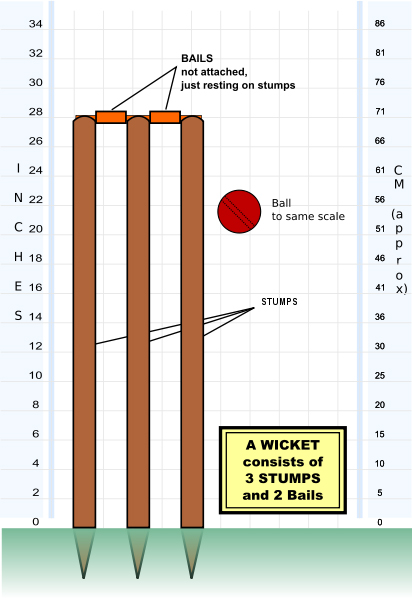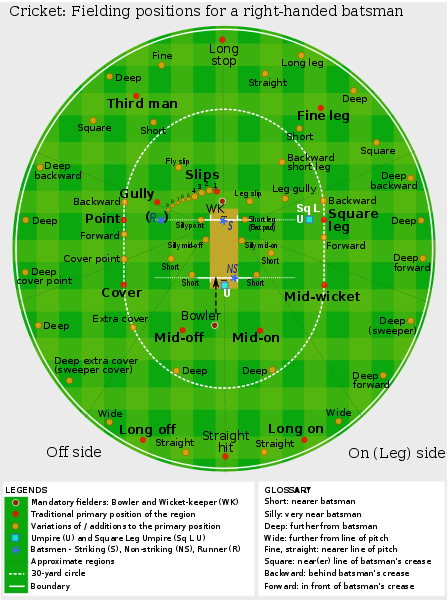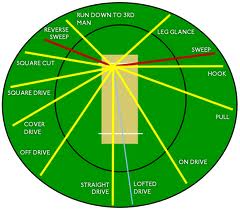|
Tamil Nadu - Sports - Cricket - About Game Play
About Stumps
A wicket consists of three stumps that are hammered into the ground, and topped with two bails. The stumps are placed in line on the bowling creases and so these must be 22 yards (20 m) apart. A bowling crease is 8 feet 8 inches (2.64 m) long with the middle stump placed dead centre. The popping crease has the same length, is parallel to the bowling crease and is 4 feet (1.2 m) in front of the wicket. The return creases are perpendicular to the other two; they are adjoined to the ends of the popping crease and are drawn through the ends of the bowling crease to a length of at least 8 feet (2.4 m).
When bowling the ball, the bowler's back foot in his delivery stride must land within the two return creases while his front foot must land on or behind the popping crease. If the bowler breaks this rule, the umpire calls No ball. The importance of the popping crease to the batsman is that it marks the limit of his safe territory for he can be stumped or run out if the wicket is broken while he is out of his ground. Now free hit given to batsman for every No ball with all safe territory. |
 |
Umpires and Scorers
The game on the field is regulated by two umpires, one of whom stands behind the wicket at the bowler's end, the other in a position called square leg, a position 15–20 meters to the side of the on strike batsman. When the bowler delivers the ball, the umpire at the wicket is between the bowler and the non-striker. The umpires confer if there is doubt about playing conditions and can postpone the match by taking the players off the field if necessary, for example rain or deterioration of the light. Off the field and in televised matches, there is often a third umpire who can make decisions on certain incidents with the aid of video evidence. The third umpire is mandatory under the playing conditions for Test matches and limited over’s internationals played between two ICC full members. These matches also have a match referee whose job is to ensure that play is within the Laws of cricket and the spirit of the game.
About Overs
The bowler bowls the ball in sets of six deliveries and each set of six balls is called an over. This name came about because the umpire calls over when six balls have been bowled. At this point, another bowler is deployed at the other end, and the fielding side changes ends while the batsmen do not. A bowler cannot bowl two successive over’s, although a bowler can bowl unchanged at the same end for several over’s. The batsmen do not change ends and so the one who was non-striker is now the striker and vice-versa. The umpires also change positions so that the one who was at square leg now stands behind the wicket at the non-striker's end.
About Fielding
All eleven players on the fielding side take the field together. One of them is the wicket-keeper keeper who operates behind the wicket being defended by the batsman on strike. Wicket-keeping is normally a specialist occupation and his primary job is to gather deliveries that the batsman does not hit, so that the batsmen cannot run byes. He wears special gloves, a box over the groin, and pads to cover his lower legs. Owing to his position directly behind the striker, the wicket-keeper has a good chance of getting a batsman out caught off a fine edge from the bat. He is the only player who can get a batsman out stumped.
Feilding Positions for Both Left & Right handed Batsmans

About Runs & Shots
The primary concern of the batsman on strike is to prevent the ball hitting the wicket and secondarily to score runs by hitting the ball with his bat so that he and his partner have time to run from one end of the pitch to the other before the fielding side can return the ball. To register a run, both runners must touch the ground behind the crease with either their bats or their bodies. Each completed run increments the score. More than one run can be scored from a single hit; but, while hits worth one to three runs are common, the size of the field is such that it is usually difficult to run four or more. To compensate for this, hits that reach the boundary of the field are automatically awarded four runs if the ball touches the ground to the boundary or six runs if the ball clears the boundary on the full. The batsmen do not need to run if the ball reaches or crosses the boundary.

Hits for five are unusual and generally rely on the help of overthrows by a fielder returning the ball. If an odd number of runs are scored by the striker, the two batsmen have changed ends, and the one who was non-striker is now the striker. Only the striker can score individual runs, but all runs are added to the team's total. Running is a calculated risk because if a fielder breaks the wicket with the ball while the nearest batsman is out of his ground he does not have part of his body or bat in contact with the ground behind the popping crease the batsman is run out.
Extra Runs from Feilding side
Additional runs can be gained by the batting team as extras due to errors made by the fielding side.This is achieved in four ways:
1. No ball : A penalty of one extra that is conceded by the bowler if he breaks the rules of bowling either by
(i) Using an inappropriate arm action;
(ii) Overstepping the popping crease;
(iii) Having a foot outside the return crease. In addition, the bowler has to re-bowl the ball. In limited over’s matches, a no ball are called if the bowling team's field setting fails to comply with the restrictions. In shorter formats of the game (20–20, ODI) the free hit rule has been introduced. The ball following a front foot no-ball will be a free-hit for the batsman, whereby he is safe from losing his wicket except for being run-out.
2. Wide : A penalty of one extra that is conceded by the bowler if he bowls so that the ball is out of the batsman's reach; as with a no ball, a wide must be re-bowled.
3. Bye : Extra(s) awarded if the batsman misses the ball and it goes past the wicketkeeper to give the batsmen time to run in the conventional way (note that one mark of a good wicketkeeper is one who restricts the tally of byes to a minimum).
4. Leg bye : Extra(s) awarded if the ball hits the batsman's body, but not his bat, while attempting a legitimate shot, and it goes away from the fielders to give the batsmen time to run in the conventional way.
When the bowler has bowled a no ball or a wide, his team incurs an additional penalty because that ball has to be bowled again and hence the batting side has the opportunity to score more runs from this extra ball. The batsmen have to run to claim byes and leg byes but these only count towards the team total, not to the striker's individual total for which runs must be scored off the bat.
|